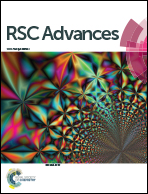Formation mechanism of thermally expandable microspheres of PMMA encapsulating NaHCO3 and ethanol via thermally induced phase separation
Abstract
Thermally expandable microspheres (TEMs), employing PMMA as the shell and NaHCO3/ethanol as the core, were prepared via thermally induced phase separation (TIPS). The addition of NaHCO3 improves the foaming properties of the TEMs. A mechanism for TEMs formation was proposed, comprising the following steps: (1) the separation of homogeneous polymer solutions into polymer-rich and polymer-poor phases upon cooling, where decreases in both interfacial tension and interfacial free energy (ΔG) facilitate sphere formation in a polymer-rich phase located in the polymer-poor phase; (2) the deposition of PMMA and shell formation at the interface, aided by the acute contact angle (θ) and positive spreading coefficient (S); (3) the constant deposition of PMMA shells from both the polymer-rich phase and polymer-poor phase upon cooling; and (4) the detachment of TEMs from each other facilitated by shear force from stirring. This mechanism was supported by calculations, and the effects of quench rates and stirring speeds.



 Please wait while we load your content...
Please wait while we load your content...